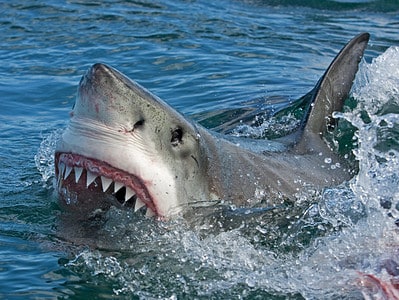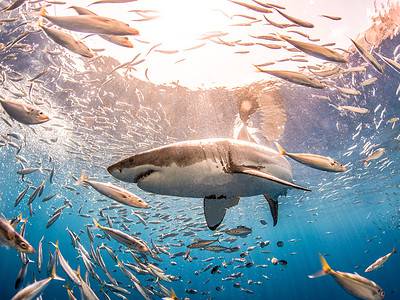King Mackerel
Scomberomorus cavalla
Advertisement
King Mackerel Scientific Classification
- Kingdom
- Animalia
- Phylum
- Chordata
- Class
- Actinopterygii
- Order
- Scombriformes
- Family
- Scombridae
- Genus
- Scomberomorus
- Scientific Name
- Scomberomorus cavalla
Read our Complete Guide to Classification of Animals.
King Mackerel Conservation Status
King Mackerel Facts
- Prey
- Smaller fish, squid
- Biggest Threat
- Sharks, Tuna
- Predators
- Sharks, Tuna, Bottlenose dolphin
- Diet
- Carnivore
King Mackerel Physical Characteristics
- Color
- Grey
- Silver
- Skin Type
- Scales
- Lifespan
- 20 years
- Weight
- 100 pounds
- Length
- 5 feet
- Age of Sexual Maturity
- 2 years
- Venomous
- No
- Aggression
- Medium
View all of the King Mackerel images!
King mackerel is a species of fish that is popular in recreational fishing as well as commercial fishing for seafood lovers. They can be found in the Atlantic Ocean and the Gulf of Mexico, with two large stock populations that are tracked by the National Oceanic and Atmospheric Administration (NOAA) Fisheries. They are considered sustainable seafood due to their large, healthy population in the wild.
5 King Mackerel Facts
- King mackerel can weigh as much as 100 pounds!
- They are a popular fish for recreational fishermen and the commercial fishing industry.
- Much like in hunting, there is a season when you can catch king mackerel fish.
- King mackerel have hard bony skeletons.
- Two main areas where king mackerel live are the Atlantic Ocean and the Gulf of Mexico.
Classification and Scientific Name
While there are a lot of types of mackerel, king mackerel is one individual species. Its scientific name is Scomberomorus cavalla. They belong to the Scombridae family, which includes mackerel, tuna, and the less popular bonito fish. All of these fish are edible and popular in both commercial and recreational fishing. Fish in this family have two dorsal fins and smaller fins, called finlets at the rear of their body.
King mackerel are part of the Scombriformes order. All of the fish in this order are bony fish, which means that they have skeletons made of bone rather than cartilage. They belong to the Actinopterygii class, also known as ray-finned fishes. Their fins look like rays, with interior spines that give them structure and shape. Over 50% of the world’s vertebrate species belong to the Actinopterygii class.
Along with all other fish, king mackerel belong to the Chordata phylum. More specifically, they are part of the Chraniata subphylum. This means that they have hard bones. Other vertebrates, including mammals, amphibians and reptiles, and birds, are part of this subphylum. King mackerel are part of the overall Animalia kingdom.
Species
There is only one species of king mackerel, Scomberomorus cavalla. They do share many physical similarities with other species of mackerel, most notably the Spanish mackerel. They can also be found in the same areas. Many people who are interested in fishing for king mackerel should also plan for Spanish mackerel.
King Mackerel Appearance

©Coastal Girl/Shutterstock.com
King mackerel are mostly gray and silver. Their backs tend to be darker, described by NOAA as “iron gray.” King mackerel’s sides and bellies have a silvery sheen. Their fins are similarly colored. They can have spots but not all king mackerel do.
One of the best ways to tell king mackerel apart from other mackerel species, most notably Spanish mackerel, is the coloring of their anterior dorsal fin. This is the fin that is on the top and toward the front of their bodies. It is dark gray in color, matching their back. They also tend to have a narrower body than the bulky Spanish mackerel.
These fish are quite large, weighing as heavy as 100 pounds. They can grow to over 5 feet. King mackerel live up to 20 years or more. Like other mackerel species, as well as tuna, the older they are, the larger they tend to be. They reach maturity around age 2.
Distribution, Population, and Habitat
There are two main areas where king mackerel live, the Gulf of Mexico and the Southern Atlantic Ocean. NOAA has reported king mackerel as far north as Massachusetts and as far south in the Atlantic as Brazil. They tend to stay close to the coast although they do prefer open ocean rather than shallow areas. They are considered pelagic fish due to their habitat preferences.
King mackerel do like to live in warmer waters, which explains their preference for the Southern Atlantic and the Gulf of Mexico. They will migrate to find warmer water as well as food.
NOAA classifies king mackerel as a sustainable seafood choice. The Monterey Bay Aquarium Seafood Watch program also lists it as a Good Alternative to more vulnerable fish populations. In the past, king mackerel were overfished and their populations dwindled to dangerously low levels. With current regulations in place, those numbers have increased and they are considered stable.
Predators and Prey
These fish are carnivorous predators, eating other smaller fish as well as squid and shrimp. To grow to their large size, they need to go after plenty of food and will hunt aggressively when needed. They do not attack humans or larger fish, except in defense or when they feel threatened.
Other pelagic fish eat young king mackerel. They take around two years to mature to fully grown adults and can be prey for larger pelagic fish during those first couple of years. Even adult king mackerel are vulnerable to becoming someone else’s lunch. Bottlenose dolphins, sharks, and tuna are the most common predators of king mackerel. Because they can get quite large, not a lot of ocean life is a match for an adult king mackerel.
Reproduction and Lifespan
Female king mackerel release eggs into the water. This is a process known as spawning. Once in the water, the eggs are fertilized and they grow into baby king mackerel. Adult king mackerel can begin to reproduce around 2 years of age.
They can often live 20 years or more in the wild. Studies conducted on king mackerel specimens collected off the east coast of the United States found at least one fish that was 21 years old based on its growth rate. Scientists estimate that king mackerel grow around 2.9 mm each day during the first few months of life.
King Mackerel in Fishing and Cooking
These fish are popular in both recreational and commercial fishing. NOAA regulates commercial fishing for king mackerel and those who want to do so are required to get a permit. Once the permits run out, no other commercial fishing is allowed. This helps ensure that the population is not overfished. King mackerel must also reach a certain size threshold or be thrown back. This ensures that young fish are able to mature enough to spawn and continue to keep the population numbers where they need to be.
There is a specific season when you can fish for king mackerel in both the Atlantic Ocean and the Gulf of Mexico. These exact dates vary year-to-year based on the population. Once the appropriate number of king mackerel have been caught, the season ends to prevent overfishing. There are also restrictions on the type of nets that can be used in some places, specifically gillnets.
Some of the environmental concerns with fishing for king mackerel actually have more to do with other species that can be caught up in nets than fishing for king mackerel themselves. Fishermen use nets to fish for king mackerel and dolphins, turtles, and sharks can accidentally be caught in addition to the king mackerel. Some of these species are endangered or need special attention when it comes to conservation.
King mackerel is an oily fish with a stronger, distinct flavor. You will need to butcher it and cut it into smaller portions. King mackerel steaks can be marinated and grilled. Islamorada-style king mackerel is also popular in Florida and comes prepared with a heavy coating of cheese and herbs.
Related Animals…
View all 77 animals that start with KKing Mackerel FAQs (Frequently Asked Questions)
Where are king mackerel found?
King mackerel are found in the Atlantic Ocean and the Gulf of Mexico. They typically stay in water depths between 115 and 600 feet.
Thank you for reading! Have some feedback for us? Contact the AZ Animals editorial team.
Sources
- 01/18/2023 / Accessed January 18, 2023
- 01/18/2023 / Accessed January 18, 2023
- 01/18/2023 / Accessed January 18, 2023
- 01/18/2023 / Accessed January 18, 2023


















